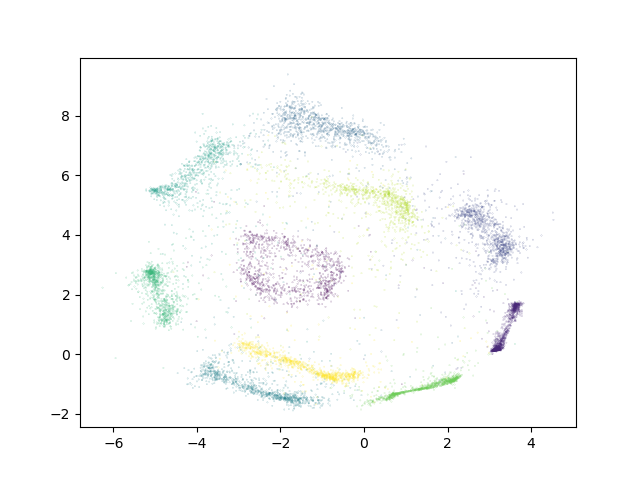Semi-supervised Dimensionality Reduction
Sometimes only part of a dataset has ground-truth labels available.
In such a scenario, ivis is still able to make use of existing
label information in conjunction with the inputs to do
dimensionality reduction when in semi-supervised mode.
When in semi-supervised mode, ivis will use labels when available
as well as the unsupervised triplet loss. However, when label
information is not available, only the unsupervised loss will be used.
By training in semi-supervised mode, we can make full use of the data
available, even if it is only partially labeled.
In order to use semi-supervised learning, mark missing labeled points
as -1 in the Y vector provided to ivis when calling fit or
fit_transform. Currently, only sparse_categorical_crossentropy loss
works with semi-supervised inputs.
Semi-supervised Classification
To train ivis in semi-supervised mode using the default softmax
classification loss, simply provide the labels to the fit method’s
Y parameter. These labels should be a list of 0-indexed
integers with each integer corresponding to a class. Missing labels
should be denoted with -1.
In the example below, we will mask 50% of the available labels for the MNIST dataset.
import numpy as np
from tensorflow.keras.datasets import mnist
from ivis import Ivis
(X_train, Y_train), (X_test, Y_test) = mnist.load_data()
# Rescale to [0,1]
X_train = X_train / 255.
X_test = X_test / 255.
# Flatten images to 1D vectors
X_train = np.reshape(X_train, (len(X_train), 28 * 28))
X_test = np.reshape(X_test, (len(X_test), 28 * 28))
# Mask labels
mask = np.random.choice(range(len(Y_train)), size=len(Y_train) // 2, replace=False)
Y_train_masked = np.array(Y_train, dtype=np.int8) # Can't use uint to represent negative numbers
Y_train_masked[mask] = -1
model = Ivis(n_epochs_without_progress=5)
model.fit(X_train, Y_train_masked)
Experimental data has shown that ivis converges to a solution faster
in supervised mode. Therefore, our suggestion is to lower the value of
the n_epochs_without_progress parameter from the default to
around 5. Here are the resulting embeddings on the testing set:

Supervision Weight
As in supervised mode, it is still possible to control the relative
importance ivis places on the labels when training in supervised mode with the
supervision_weight parameter. This variable should be a float
between 0.0 to 1.0, with higher values resulting in supervision
affecting the training process more, and smaller values resulting in it
impacting the training less. By default, the parameter is set to 0.5.
Increasing it will result in more cleanly separated classes.
weight = 0.8
model = Ivis(n_epochs_without_progress=5,
supervision_weight=weight)
model.fit(X_train, Y_train)
As an illustration of the impact the supervision_weight has on
the resulting embeddings, see the following plot of supervised ivis
applied to MNIST with different weight values:

In semi-supervised mode, the supervision weight may need to be higher to have the same effect on the resulting embeddings as in supervised mode, depending on the dataset. This is because when unlabeled points are encountered, unsupervised loss will still have an impact, while the supervised loss will not apply. The more of the dataset is unlabeled, the higher the supervision weight should be to have an impact on the embeddings.
